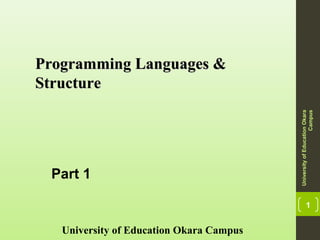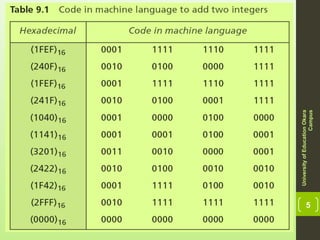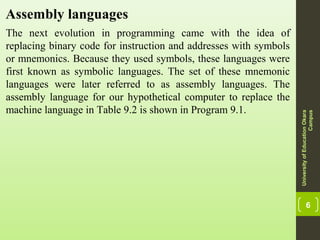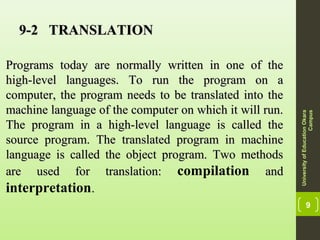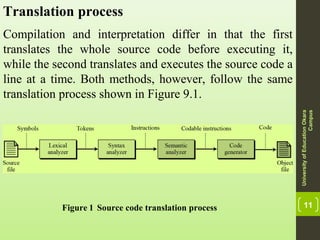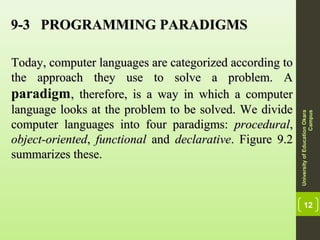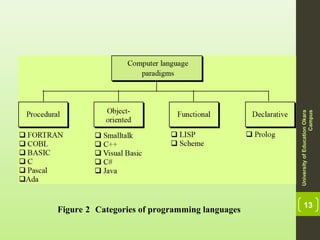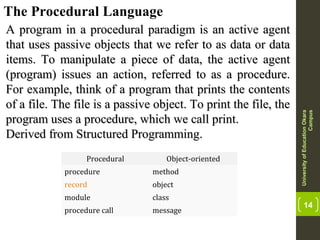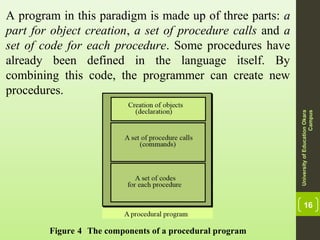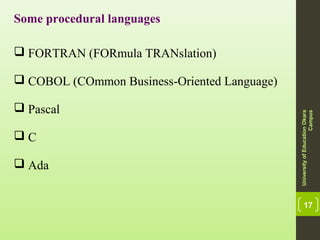Introduction to programing languages part 1
- 1. 1 Programming Languages &Programming Languages & StructureStructure University of Education Okara Campus UniversityofEducationOkara Campus Part 1
- 2. 2 Describe the evolution of programming languages from machineDescribe the evolution of programming languages from machine language to high-level languages. Understand how a program inlanguage to high-level languages. Understand how a program in a high-level language is translated into machine language.a high-level language is translated into machine language. Distinguish between four computer language paradigms.Distinguish between four computer language paradigms. Understand the procedural paradigm and the interaction betweenUnderstand the procedural paradigm and the interaction between a program unit and data items in the paradigm. Understand thea program unit and data items in the paradigm. Understand the object-oriented paradigm and the interaction between a programobject-oriented paradigm and the interaction between a program unit and objects in this paradigm. Define functional paradigmunit and objects in this paradigm. Define functional paradigm and understand its applications. Define a declaration paradigmand understand its applications. Define a declaration paradigm and understand its applications. Define common concepts inand understand its applications. Define common concepts in procedural and object-oriented languages.procedural and object-oriented languages. ObjectivesObjectives After studying this chapter, the student should be able to:After studying this chapter, the student should be able to: UniversityofEducationOkara Campus
- 3. 3 9-1 EVOLUTION9-1 EVOLUTION To write a program for a computer, we must use aTo write a program for a computer, we must use a computer language. A computer language is a set ofcomputer language. A computer language is a set of predefined words that are combined into a programpredefined words that are combined into a program according to predefined rules (according to predefined rules (syntax). Over the years,). Over the years, computer languages have evolved fromcomputer languages have evolved from machine language toto high-level languages.. UniversityofEducationOkara Campus
- 4. 4 Machine languages UniversityofEducationOkara Campus In the earliest days of computers, the only programming languages available were machine languages. Each computer had its own machine language, which was made of streams of 0s and 1s. We need to use eleven lines of code to read two integers, add them and print the result. These lines of code, when written in machine language, make eleven lines of binary code, each of 16 bits, as shown in Table 9.1. The only language understood by a computer is machine language.The only language understood by a computer is machine language.
- 6. 6 Assembly languages The next evolution in programming came with the idea of replacing binary code for instruction and addresses with symbols or mnemonics. Because they used symbols, these languages were first known as symbolic languages. The set of these mnemonic languages were later referred to as assembly languages. The assembly language for our hypothetical computer to replace the machine language in Table 9.2 is shown in Program 9.1. UniversityofEducationOkara Campus
- 7. 7 High-level languages Although assembly languages greatly improved programming efficiency, they still required programmers to concentrate on the hardware they were using. Working with symbolic languages was also very tedious, because each machine instruction had to be individually coded. The desire to improve programmer efficiency and to change the focus from the computer to the problem being solved led to the development of high-level languages. Over the years, various languages, most notably BASIC, COBOL, Pascal, Ada, C, C++ and Java, were developed. Program 9.1 shows the code for adding two integers as it would appear in the C++ language. UniversityofEducationOkara Campus
- 8. 8 UniversityofEducationOkara Campus C++ Program to add two numbers #include<iostream.h> #include<iostream.h> Void main() { Clrscr(); Int a=5, b=10; Int c = a+b; Cout<<c; Getch(); }
- 9. 9 9-2 TRANSLATION9-2 TRANSLATION Programs today are normally written in one of thePrograms today are normally written in one of the high-level languages. To run the program on ahigh-level languages. To run the program on a computer, the program needs to be translated into thecomputer, the program needs to be translated into the machine language of the computer on which it will run.machine language of the computer on which it will run. The program in a high-level language is called theThe program in a high-level language is called the source program. The translated program in machinesource program. The translated program in machine language is called the object program. Two methodslanguage is called the object program. Two methods are used for translation:are used for translation: compilation andand interpretation.. UniversityofEducationOkara Campus
- 10. 10 Compilation A compiler normally translates the whole source program into the object program. Interpretation Some computer languages use an interpreter to translate the source program into the object program. Interpretation refers to the process of translating each line of the source program into the corresponding line of the object program and executing the line. However, we need to be aware of two trends in interpretation: that is used by some languages before Java and the interpretation used by Java. UniversityofEducationOkara Campus
- 11. 11 Translation process Compilation and interpretation differ in that the first translates the whole source code before executing it, while the second translates and executes the source code a line at a time. Both methods, however, follow the same translation process shown in Figure 9.1. Figure 1 Source code translation process UniversityofEducationOkara Campus
- 12. 12 9-3 PROGRAMMING PARADIGMS9-3 PROGRAMMING PARADIGMS Today, computer languages are categorized according toToday, computer languages are categorized according to the approach they use to solve a problem. Athe approach they use to solve a problem. A paradigm, therefore, is a way in which a computer, therefore, is a way in which a computer language looks at the problem to be solved. We dividelanguage looks at the problem to be solved. We divide computer languages into four paradigms:computer languages into four paradigms: proceduralprocedural,, object-orientedobject-oriented,, functionalfunctional andand declarativedeclarative. Figure 9.2. Figure 9.2 summarizes these.summarizes these. UniversityofEducationOkara Campus
- 13. 13 Figure 2 Categories of programming languages UniversityofEducationOkara Campus
- 14. 14 The Procedural Language A program in a procedural paradigm is an active agentA program in a procedural paradigm is an active agent that uses passive objects that we refer to as data or datathat uses passive objects that we refer to as data or data items. To manipulate a piece of data, the active agentitems. To manipulate a piece of data, the active agent (program) issues an action, referred to as a procedure.(program) issues an action, referred to as a procedure. For example, think of a program that prints the contentsFor example, think of a program that prints the contents of a file. The file is a passive object. To print the file, theof a file. The file is a passive object. To print the file, the program uses a procedure, which we call print.program uses a procedure, which we call print. Derived from Structured Programming.Derived from Structured Programming. UniversityofEducationOkara Campus Procedural Object-oriented procedure method record object module class procedure call message
- 15. 15 Figure 3 The concept of the procedural paradigm UniversityofEducationOkara Campus
- 16. 16 A program in this paradigm is made up of three parts: a part for object creation, a set of procedure calls and a set of code for each procedure. Some procedures have already been defined in the language itself. By combining this code, the programmer can create new procedures. Figure 4 The components of a procedural program UniversityofEducationOkara Campus
- 17. 17 Some procedural languages FORTRAN (FORmula TRANslation) COBOL (COmmon Business-Oriented Language) Pascal C Ada UniversityofEducationOkara Campus

